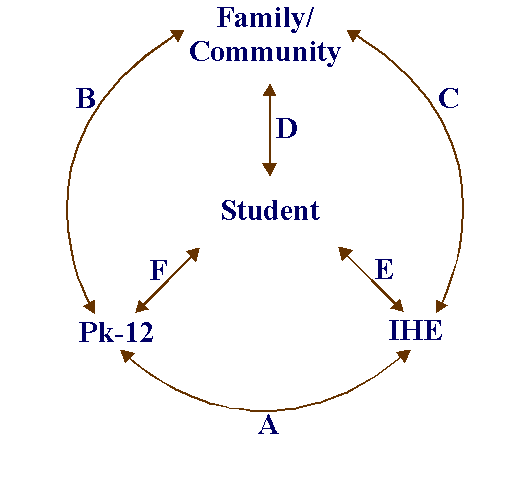• by Rosana Rodríguez, Ph.D., Abelardo Villarreal, Ph.D., and Ricardo R. Rodríguez • IDRA Newsletter • November – December 2000 • 



The education of Latino youth is a social justice issue and a national economic imperative. The Latino population is growing dramatically. One out of every four students in a central city public school was Hispanic in 1996 (NCES, 1999). That is an increase from 1972 when only one out of every 10 students was Hispanic. This is a great opportunity for communities and educational institutions to capitalize on the untapped potential of various minority and ethnic groups.
Hispanic students in secondary education represent 13 percent of the current school population in grades nine through 12. By the year 2030, they will represent 23 percent (White House Initiative, January 2000).
Hispanic students currently represent 14.5 percent (3.6 million) of the total college-age population of 18 through 24 years (White House Initiative, January 2000). By the year 2025, they will comprise 22 percent. Educational institutions are under enormous pressure to create powerful learning environments for this growing population.
During the past year, 18 collaboratives among kindergarten through 12th grade (K-12) schools, colleges and universities, and communities have engaged in a remarkable endeavor. The ENLACE initiative promises to change the way educational institutions have traditionally addressed the education of Latino youth. The initiative is supported by the W.K. Kellogg Foundation, and the Intercultural Development Research Association is the managing partner.
The collaboratives have begun to systematically create new and innovative opportunities to engage Latino youth. Together, they are creating a critical and vibrant force with a potential to influence public policy and make fundamental institutional changes that will lead to increased access, success and completion for Latino students at all educational levels.
The collaboratives represent a critical mass of people committed to public and institutional change on behalf of students. Institutions of higher education, as lead partners with K-12 schools and communities, have embarked upon a momentous journey at strategic locations in Arizona, California, Colorado, Florida, Illinois, New Mexico, New York and Texas. These states reflect the diversity of this country’s increasingly growing Latino population.
The ENLACE initiative’s focus is to create an active partnership among the major stakeholders in the educational pipeline. The key responsibilities of the collaboratives are to create, implement and evaluate fundamental institutional and policy changes that result in powerful learning environments for Latino youth.
The time is right for the kind of courageous commitment these partners are making. The stakes could not be higher for Latino youth, indeed all youth, to reach their fullest potential.
A major evaluation question being addressed by these 18 collaboratives is to see how partnerships can support Latino student success among K-12 schools, higher education and communities. This article highlights some lessons learned from the past year of building partnerships. Some of the partnerships were strong and are becoming stronger, and others have just begun to join forces, emerging during the past 12 months of planning with support through their W.K. Kellogg Foundation planning grants in 2000.
A cohesive and powerful movement is emerging. Also, a new way of co-creating a better educational reality for young people is forming based on the principles of engagement, access and opportunity.
Building Meaningful Relationships
Successful partnerships share a purpose, a vision and a commitment to influence institutional and public policy changes that will result in increased Latino enrollment and graduation rates from our high schools and higher education institutions. Successful partnerships are characterized by relationships that are based on mutual respect, trust, openness, commitment and passion for educational equity and excellence for all youth. It is the formation and nurturing of strong consistent relationships built on respect and trust and focused on the well-being of youth that makes the difference.
Some essential elements of successful partnerships are a delineation, a definition and a mutual understanding of the relationships that provide the glue for the stakeholders to act cohesively in a transformational effort to address the education of Latino youth comprehensively. Without this cohesiveness, we would have a kaleidoscope of unrelated efforts with limited success and impact.
In ENLACE, these relationships are bound by a definition of each partner’s role in contributing to and ensuring the success of Latino youth. The figure in the box depicts the issues and roles that are addressed in the relationships among the stakeholders represented in collaborators’ evaluation reports.
In the meantime, key learnings to date are germinating from these successful partnerships. The following are eight lessons that have emerged during this past ENLACE planning year.
Recognizing the Strength of Communities and Families
Inclusive partnerships recognize that our strength lies in our communities and families. The ENLACE partners pro-actively have included, valued and integrated the assets brought forth by parents and communities during the planning phase. They see the importance of linking life-long learning to the language and culture of the families in the community. Successful ENLACE collaborations recognize and value traditional as well as nontraditional learning. They seek out and engage parents, community-based organizations, businesses and community members in the decision-making process across sectors.
In the ENLACE initiative, the community is valued as a cornerstone of learning, an indispensable partner that supports students’ right to know and values their unique diversity and that honors and strengthens culture, language and values.
It has been said, “A people without knowledge of their language and culture is like a tree without roots.” In this new paradigm, language and culture are not viewed as problems to be solved, but as blessings and strengths to our entire society and as integral parts of the learning process.
Developing Trust
Strategic partnerships invest time and resources to develop trust and grow stronger. The ENLACE collaborations are demonstrating the importance of getting commitment and support from the top decision and policy-makers of the institutions involved.
Sustainable partnerships also require technical assistance and support in order to develop the trust that is necessary for true accountability to one another. Forced marriages usually do not work. Therefore, the elements of time and support to strengthen a partnership are very important. Time is needed in order to develop a common goal that can be articulated by all partners, one that is understood by each member and is always squarely focused on student success. These partnerships emerge with a solid and unified commitment not only for high academic expectations, but also for support and student success.
Sharing Leadership
Pro-active partnerships have a commitment to shared leadership through engagement and accountability. This leadership requires imaginative, spirited and determined commitment. The leadership teams of these collaborations include individuals from diverse backgrounds, disciplines and sectors. Resources are allocated to strengthen existing as well as emerging leadership by incorporating student voices into key decision-making roles.
The key question is: Leadership for what? The answer for ENLACE partners is: leadership for engagement and student success. Because of this, support for student leadership development is at the core of successful ENLACE partnerships. The incorporation of student voices in the planning and decision-making processes is the key to long-term sustainability.
Articulating a Shared Vision
Engaged partnerships have a clearly articulated and strongly shared vision that is inclusive of the role and importance each partner will play. This vision is broader than the individual agendas of each partner or institution. The word “ENLACE” is derived from the Spanish word enlazar, which means to weave or work together in such a way that the whole is stronger than the parts. It is this inter-connected vision of student success through engagement that moves the partnerships forward strategically.
Each partner comes to the collaboration with a unique role and is valued for the strength it brings to the shared vision. Furthermore, each partner brings a valued and respected skill and perspective that will help in creating an effective strategy and plan for student success. Diversity is valued in these collaborations as essential for the creation of a shared vision and a successful partnership.
Planning Together
Visionary partnerships develop a viable plan, a blueprint for educational change. This plan is created by all of the members of the collaborations. The process begins by taking the time to carefully analyze and understand the students within the local context of their respective sites. These partnerships begin by identifying key data, setting goals that are clear and holding themselves accountable for achieving these goals.
Successful partnerships establish baseline data as a point of reference from which to proceed. They review relevant national data and best practice models as they develop strategies that are tailor-made to their students in the local environment. They create a viable plan, which becomes their map for engagement with one another. Each member of the successful collaborations can articulate the vision and the goals for their blueprint and understands the unique part they play in supporting student access and academic success. This unified vision, combined with a viable plan, has great promise for yielding several models for best practice within diverse community contexts.
Creating Principles of Engagement
Interactive partnerships develop and adhere to principles of engagement. Some of the strongest partnerships have taken the time to identify the ways in which they plan to interact with one another, including how they intend to resolve any differences that might occur. These partnerships are resilient and have promise of long-lasting success because they recognize that diversity is their strength and that, through their diverse opinions and perspectives, they agree to disagree respectfully without losing their balance or central focus. Again, they keep their “eyes on the prize” of student success and the overall goal of increased access, retention and graduation.
These partnerships agree on how resources will be shared and how decisions will be made. These agreements are an asset-based approach (i.e., a focus on valuing the assets of each partner) vs. a deficit or blaming approach or perspective. Within these terms of engagement are explicit values and principles that are shared by all the members and reflect the heart of the work, ultimately the goal of student success.
Planning for Impact
Strategic partnerships are resilient because they plan for impact and sustainability from the beginning. In order to do this, collaborators develop a network of key stakeholders, both internal and external. Their impact strategies are comprehensive and include a communications and dissemination strategy from the beginning to assess progress made, make mid-course adjustments and inform key stakeholders about their projects on an ongoing basis. They identify stories that capture the real-life people behind the numbers. This helps to get the word out about best practices to potential funders and policy-makers with whom they regularly communicate.
They also identify specific practice and policy targets for change within the system or institutions involved and find ways to link ENLACE efforts to other key programs in order to leverage resources.
This type of comprehensive planning also calls for a comprehensive evaluation plan that is identified and implemented from the very beginning of the project. The W.K. Kellogg Foundation emphasizes the importance of evaluation that “seeks to improve rather than to prove.” Therefore successful partnerships consider evaluation as a capacity-building strategy, another tool in the overall management of their projects. They are deliberate in sharing evaluation information with other members of their collaborations on a regular basis.
Learning from Each Other
In cohesive partnerships, each choice made by the partners creates a future. Each person influences and is influenced by the other partners. These partnerships help all of us to learn new ways of understanding and relating to one another, valuing the uniqueness of each partner in supporting student success. Successful partnerships recognize and capitalize on the value of external support for consultation and information. This external support can come in the form of technical assistance in project planning and development, program education, communication and dissemination, planning for sustainability, and proposal development.
Summary
These types of partnerships are forging ahead for a new way of educational planning, a new way of relating to diverse partners who together make responsible choices on behalf of youth. They are discovering higher forms of creating solutions that can support student success. Their trust keeps them together. Their vision and talent will guide them. They are exercising authentic power within their institutions and communities to create educational reform.
These partnerships are crucial because no one sector or institution can succeed in this effort alone. We wish them much success in this important endeavor and look with anticipation to the models they are creating, for a better future on behalf of all children and youth.
All of the collaborations enthusiastically are seeking additional funding from the W.K. Kellogg Foundation and other funders to continue the important work they have begun. In early January, the W.K. Kellogg Foundation will announce its next phase of support for the four-year ENLACE initiative’s implementation. While it cannot support all the partnerships involved, the foundation hopes other businesses, foundations and local supporters will come forward to become learning partners with these 18 collaborations.
Let us aggressively support their efforts, not only for the valuable lessons and models emerging from these collaborations focused on Latino student success, but also for the light of wisdom that these diverse partners can shed on our collective efforts for all youth. We wish each of the partners much success as they continue their bold experiments in creating the public and institutional will for positive educational change.
Resources
Carnevale, A.P. and R.A. Fry, S. Turner. “Growing Inequality in Collegiate Attainment: Evidence on the Role of Family Income,” Paper presented at the 2000 American Economics Association meetings (Boston, Mass.: January 2000).
Chang, M.J. “Racial Diversity in Higher Education: Does a Racially Mixed Student Population Affect Educational Outcomes?,” doctoral dissertation (Ann Arbor, Mich.: UMI Dissertation Services, 1996).
Ellwood, D.T. and T.J. Kane. “Who is Getting a College Education? Family Background and the Growing Gaps in Enrollment,” Mimeo (September 25, 1998).
Hernandez, D.J. “Population Change and the Family Environment of Children,” Trends in the Well-Being of America’s Children and Youth, first edition (Washington, D.C.: U.S. Department of Health and Human Services, ASPE, 1996).
Hurtado, S. and A. Clayton-Pedersen, J. Milem, W. Allen. “Enacting Diverse Learning Environments: Improving the Climate for Racial/Ethnic Diversity in Higher Education,” ASHE-ERIC Higher Education Report 26, No. 8 (Washington, D.C.: George Washington University, Graduate School of Education and Human Development, 1999).
Kellogg Commission on the Future of State and Land-Grant Universities. Returning to Our Roots: The Engaged Institution (Washington, D.C.: National Association of State Universities and Land-Grant Colleges, February 1999).
McKnight, J.L. and J.P. Kretzmann. Building Communities from the Inside Out (Chicago, Ill.: ACTA Publication, 1993).
National Center for Education Statistics. The Condition of Education, 1999, Indicator 46 (Washington, D.C.: U.S. Department of Education, 1999).
National Center for Education Statistics. Digest of Education Statistics, 1998, Table 207 (Washington, D.C.: U.S. Department of Education, 1998).
President’s Advisory Commission on Educational Excellence for Hispanic Americans. Testing Hispanic Students in the United States: Technical and Policy Issues (Washington, D.C.: U.S. Department of Education, May 2000).
Rodriguez, R.G. and A. Villarreal. “Development Through Engagement: Valuing the ‘At-Promise’ Community,” IDRA Newsletter (San Antonio, Texas: Intercultural Development Research Association, August 2000).
Scott, B. “We Should Not Kid Ourselves: Excellence Requires Equity,” IDRA Newsletter (San Antonio, Texas: Intercultural Development Research Association, February 2000).
Sorensen, S. and D.J. Brewer, S.J. Carroll, E. Bryton. Increasing Hispanic Participation in Higher Education: A Desirable Public Investment (Santa Monica, Calif.: Rand Corporation, 1995).
White House Initiative on Educational Excellence for Hispanic Americans. Latinos in Early Childhood Education (Washington, D.C.: U.S. Department of Education, January 2000).
White House Initiative on Educational Excellence for Hispanic Americans. What Works for Latino Youth (Washington, D.C.: U.S. Department of Education, September 2000).
ENLACE Initiative Stakeholder Relationships
|
Rosana G. Rodríguez, Ph.D., is the division director of the IDRA Division of Community and Public Engagement. Abelardo Villarreal, Ph.D., is the division director of the IDRA Division of Professional Development. Ricardo R. Rodríguez is an education assistant in the IDRA Division of Professional Development. Comments and questions may be directed to them via e-mail at feedback@idra.org.
[©2000, IDRA. This article originally appeared in the November – December 2000 IDRA Newsletter by the Intercultural Development Research Association. Permission to reproduce this article is granted provided the article is reprinted in its entirety and proper credit is given to IDRA and the author.]



